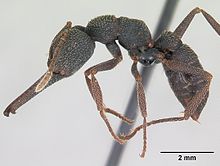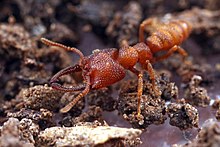| Mystrium | |
|---|---|

| |
| Mystrium mysticum worker from Madagascar | |
| Scientific classification | |
| Domain: | Eukaryota |
| Kingdom: | Animalia |
| Phylum: | Arthropoda |
| Class: | Insecta |
| Order: | Hymenoptera |
| Family: | Formicidae |
| Subfamily: | Amblyoponinae |
| Tribe: | Amblyoponini |
| Genus: | Mystrium Roger, 1862 |
| Type species | |
| Mystrium mysticum Roger, 1862 | |
| Diversity | |
| 14 species | |
Mystrium is a rare genus of ants in the subfamily Amblyoponinae. First described by Roger (1862) with the description of the queen of M. mysticum, the genus contains 14 species, all of which occur in the rainforests of the Old World with over half of the species endemic to the Malagasy region.
Distribution
All species occur in the rainforests of the Old World, with most found in tropical Africa: ten of them are restricted to Madagascar (and its adjacent islands) and one is recorded from continental Africa (M. silvestrii). M. camillae is widespread in the Indo-Australian region, and M. leonie and M. maren are known from Indonesia.
Taxonomic history
After Roger (1862) established Mystrium with a single species from Madagascar, Mystrium mysticum, Forel described five additional species in the Malagasy region between 1895 and 1899. The first record of Mystrium outside the Malagasy region was Mystrium camillae from Myanmar, and the second was Mystrium silvestrii from Cameroon. A subspecies was later established under Mystrium camillae, Mystrium camillae javana; however, this subspecies was synonymized with Mystrium camillae by Brown (1960). Outside the Malagasy region, Mystrium oculatum, was described from China, and Mystrium leonie and Mystrium maren from West Papua, Indonesia. Mystrium oculatum was synonymized with Mystrium camillae by Bihn and Verhaagh (2007). Yoshimura and Fisher (2014) described six new Malagasy species and synonymized two existing names, Mystrium fallax and M. stadelmanni with M. voeltzkowi and M. mysticum, respectively.
Description

The genus is morphologically very peculiar within the poneromorph subfamily group and has the following combination of characteristics: the very wide head; spatulate or squamate hairs on the head; and long, narrow mandibles with a double row of teeth on the inner margins. Monophyly of the genus is strongly supported by a recent molecular phylogenetic study by Saux et al. (2004).
Mandible snap
In December 2018, researchers from the University of Illinois, North Carolina State University and the Smithsonian Museum of Natural History conducted studies which found that ants of the species Mystrium camillae (also known as Dracula ants) can snap their jaws at speeds of up to 200 mph, making it the fastest recorded animal movement. Their research, published in the peer-reviewed Royal Society Open Science journal, noted that the jaw structure was different from other strong-jawed ants in that "instead of using three different parts for the spring, latch and lever arm, all three are combined in the mandible." They achieve this speed by pressing the tips of their mandibles together, in a spring-loading action (thereby continuously increasing tension), until one slides over the other in a snapping motion, similar to a human finger snap.
Biology
Besides their bizarre morphology Mystrium ants have also evolved some unique biological traits. They have a unique defense mechanism in which they snap their mandibles to generate a powerful strike (Gronenberg et al. 1998; Moffett 1986). Molet et al. (2006) demonstrated that, in some species of Mystrium known from Madagascar, normal queens are replaced by wingless reproductives which are smaller than workers. Because Mystrium are rarely encountered, information on their general biology, ecology and behavior remains sparse. They are presumably predaceous like other species of the subfamily Amblyoponinae, although no direct evidence is available. Species in Madagascar show two distinct reproductive strategies and relevant colony structures. In some species each colony has a single dealate queen with a larger thorax than workers but with mandibles similar to those of the workers. In colonies of other species winged queens are missing and half of the female adults belong to wingless reproductives which are smaller and allometrically distinct from workers.
Species
- Mystrium barrybressleri Yoshimura & Fisher, 2014
- Mystrium camillae Emery, 1889
- Mystrium eques Yoshimura & Fisher, 2014
- Mystrium janovitzi Yoshimura & Fisher, 2014
- Mystrium labyrinth Yoshimura & Fisher, 2014
- Mystrium leonie Bihn & Verhaagh, 2007
- Mystrium maren Bihn & Verhaagh, 2007
- Mystrium mirror Yoshimura & Fisher, 2014
- Mystrium mysticum Roger, 1862
- Mystrium oberthueri Forel, 1897
- Mystrium rogeri Forel, 1899
- Mystrium shadow Yoshimura & Fisher, 2014
- Mystrium silvestrii Santschi, 1914
- Mystrium voeltzkowi Forel, 1897
References
- Bolton, B. (2014). "Mystrium". AntCat. Retrieved 3 July 2014.
- "Genus: Mystrium". antweb.org. AntWeb. Retrieved 21 September 2013.
- ^ Bihn & Verhaagh 2007, p. 1
- Bihn & Verhaagh 2007, p. 5
- ^ Bihn & Verhaagh 2007, p. 7
- Yoshimura & Fisher 2014, pp. 2, 44, 56, 68
- Yoshimura & Fisher 2014, p. 2
- Yoshimura & Fisher 2014, p. 1
- ^ "Dracula ants possess fastest known animal appendage: The snap-jaw". ScienceDaily. Retrieved 2018-12-12.
- Fredrick J. Larabee , Adrian A. Smith and Andrew V. Suarez (12 December 2018). "Snap-jaw morphology is specialized for high-speed power amplification in the Dracula ant, Mystrium camillae". Royal Society Open Science. 5 (12): 181447. doi:10.1098/rsos.181447. PMC 6304126. PMID 30662749.
- Brown, W.L. (1960) Contributions toward a reclassification of the Formicidae. III. Tribe Amblyoponini (Hymenoptera). Bulletin of the Museum of Comparative Zoology at Harvard College, 122, 145–230.
- Gronenberg, W., Hölldobler, B. & Alpert, G.D. (1998) Jaws that snap: control of mandible movements in the ant Mystrium. Journal of Insect Physiology, 44, 241–253.
- Moffett, M. (1986) Mandibles that snap: notes on the ant Mystrium camillae Emery. Biotropica, 18, 361–362.
- Roger, J. (1862) Einige neue exotische Ameisen-Gattungen und Arten. Berliner Entomologische Zeitschrift, 6, 233–254.
- Saux, C., Fisher, B.L. & Spicer, G.S. (2004) Dracula ant phylogeny as inferred by nuclear 28S rDNA sequences and implications for ant systematics (Hymenoptera: Formicidae: Amblyoponinae). Molecular Phylogenetics and Evolution, 33, 457–468.
 This article incorporates text from a scholarly publication published under a copyright license that allows anyone to reuse, revise, remix and redistribute the materials in any form for any purpose: Bihn, Jochen H.; Verhaagh, Manfred (2007), "A review of the genus Mystrium (Hymenoptera: Formicidae) in the Indo-Australian region." (PDF), Zootaxa, 1642: 1–12, doi:10.11646/zootaxa.1642.1.1 Please check the source for the exact licensing terms.
This article incorporates text from a scholarly publication published under a copyright license that allows anyone to reuse, revise, remix and redistribute the materials in any form for any purpose: Bihn, Jochen H.; Verhaagh, Manfred (2007), "A review of the genus Mystrium (Hymenoptera: Formicidae) in the Indo-Australian region." (PDF), Zootaxa, 1642: 1–12, doi:10.11646/zootaxa.1642.1.1 Please check the source for the exact licensing terms. This article incorporates text from a scholarly publication published under a copyright license that allows anyone to reuse, revise, remix and redistribute the materials in any form for any purpose: Yoshimura, M.; Fisher, B. (2014). "A revision of the ant genus Mystrium in the Malagasy region with description of six new species and remarks on Amblyopone and Stigmatomma (Hymenoptera, Formicidae, Amblyoponinae)". ZooKeys (394): 1–99. Bibcode:2014ZooK..394....1Y. doi:10.3897/zookeys.394.6446. PMC 3978267. PMID 24715784. Please check the source for the exact licensing terms.
This article incorporates text from a scholarly publication published under a copyright license that allows anyone to reuse, revise, remix and redistribute the materials in any form for any purpose: Yoshimura, M.; Fisher, B. (2014). "A revision of the ant genus Mystrium in the Malagasy region with description of six new species and remarks on Amblyopone and Stigmatomma (Hymenoptera, Formicidae, Amblyoponinae)". ZooKeys (394): 1–99. Bibcode:2014ZooK..394....1Y. doi:10.3897/zookeys.394.6446. PMC 3978267. PMID 24715784. Please check the source for the exact licensing terms.
External links
 Media related to Mystrium at Wikimedia Commons
Media related to Mystrium at Wikimedia Commons
| Taxon identifiers | |
|---|---|
| Mystrium | |